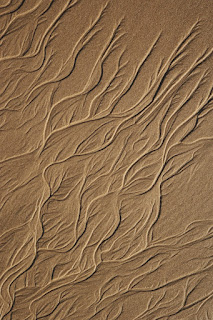Pattern,Form and Texture
Pattern
 Using natural patterns in photography is a great way to improve your compositional skills, and can also help transform the ordinary into something extraordinary keep your eyes open,Develop an eye for the endless range of patterns offered by the natural world, from lines of trees to the veins in a leaf,The thinking behind the shot,Unlike many other forms of photography, you don’t often plan to head out and shoot natural patterns – they just present themselves while you’re out photographing something else.But they only present themselves if your eyes are open to this kind of image, and can spot the potential of seemingly mundane subjects.On the morning I took this shot, I was really hoping to shoot a much wider view that included an expanse of foreground rocks extending across a coastal bay to some distant hills, but this shot wasn’t on the cards due to the overcast light.So instead, I pointed my lens downwards to concentrate on the shape and form of the subtly-coloured rocks and pebbles at my feet.
Using natural patterns in photography is a great way to improve your compositional skills, and can also help transform the ordinary into something extraordinary keep your eyes open,Develop an eye for the endless range of patterns offered by the natural world, from lines of trees to the veins in a leaf,The thinking behind the shot,Unlike many other forms of photography, you don’t often plan to head out and shoot natural patterns – they just present themselves while you’re out photographing something else.But they only present themselves if your eyes are open to this kind of image, and can spot the potential of seemingly mundane subjects.On the morning I took this shot, I was really hoping to shoot a much wider view that included an expanse of foreground rocks extending across a coastal bay to some distant hills, but this shot wasn’t on the cards due to the overcast light.So instead, I pointed my lens downwards to concentrate on the shape and form of the subtly-coloured rocks and pebbles at my feet.
Moss is a wonderful subject for pattern images because the foliage forms a carpet of symmetrically shaped leaves that are regularly spaced and uniform in colour.Star moss is an ideal subject for this kind of picture, but it remains a challenge to find a specimen that is ‘clean’ enough to create a striking image.The added attraction on this particular occasion was the jewel-like raindrops that provided something extra to bring the shot together.
Form
Shape is very two dimensional while form adds a third dimension because of the volume of an object. The eye is immediately drawn to form in an image and the art of creating this form is achieved by showing the contours of a subject. The human body as in a sumo wrestler, or the bold contours of round rocks on the seashore.Good side lighting early morning or late afternoon brings out the contoured form through shadow. Direct sunlight from above gives a very flat appearance to an image but when clouds pass over the sun form immediately rises and you have a perfect subject. Here’s a tip when trying to convey form in an image. Don’t stand front on parallel to your subject because all you tend to view is the shape without any form. Change your angle of view by moving around until shadow starts to reveal the form.By learning to photograph texture, form and pattern correctly and adding these to elements to your images you will find that a new dimension will be added to your bag of skills and your photos will improve dramatically.
Texture
 While the structure of an object is its form, the material from which it is made constitutes its texture. To simplify it the texture conveys how the subject feels; is it hard or soft, smooth or rough. If you can convey these feelings then you are translating texture visually. Contrasting a smooth object and a rough one allows you to see texture. Again, getting in closer helps achieve this feeling as well.The angle of light falling on to the texture will lift it off the image and give it feeling. It’s best revealed by angled light coming more from the side, top or rear. Front lighting will make feel flat and uninteresting, although side lighting is the most popular way of revealing texture.Shoot subjects like rope close up so that you can reveal the fibrous detail by isolating it from the other elements in the scene. If you really want to emphasize the effect of texture, angle the light more. This is achieved by shooting early morning and late afternoon.
While the structure of an object is its form, the material from which it is made constitutes its texture. To simplify it the texture conveys how the subject feels; is it hard or soft, smooth or rough. If you can convey these feelings then you are translating texture visually. Contrasting a smooth object and a rough one allows you to see texture. Again, getting in closer helps achieve this feeling as well.The angle of light falling on to the texture will lift it off the image and give it feeling. It’s best revealed by angled light coming more from the side, top or rear. Front lighting will make feel flat and uninteresting, although side lighting is the most popular way of revealing texture.Shoot subjects like rope close up so that you can reveal the fibrous detail by isolating it from the other elements in the scene. If you really want to emphasize the effect of texture, angle the light more. This is achieved by shooting early morning and late afternoon.


Comments
Post a Comment